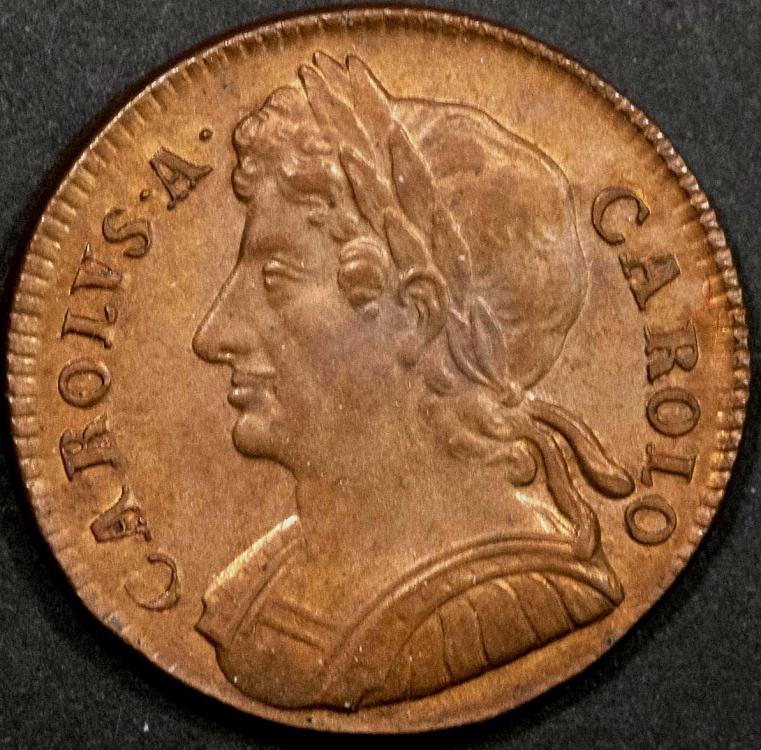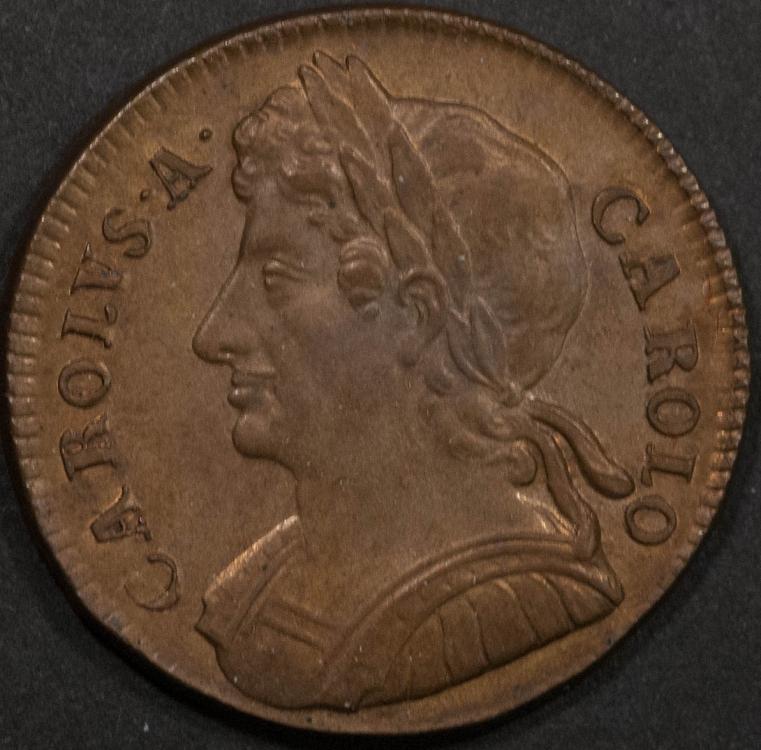-
Posts
12,713 -
Joined
-
Last visited
-
Days Won
331
Content Type
Profiles
Forums
Events
Downloads
Store
Gallery
Articles
Everything posted by Rob
-

The Copthorne collection of pennies
Rob replied to PWA 1967's topic in British Coin Related Discussions & Enquiries
The limit for most collections is determined by one of three things - funds, telomeres or patience. Prolong all of these limiting factors and who knows how good the collection would become. Far better to take the view that if you like it, so will someone else, so you'd better buy it. There's nothing wrong with having gaps in a collection as it always gives you something to go for. Spread the net wide enough and you will always be able to find something. I've been stuck at around 50% complete for a while now as I discover more criteria that I can fill. These are usually the result of me looking for an excuse to squeeze another too nice to sell coin into the collection, even though it didn't tick any existing criteria on the list. -
I note that the RM talks about silver £5 to £100 commemorative coins. Does this refer to silver only or both Ag and Cu-Ni. Clearly the face value of a silver £5 is £5, but its intrinsic value is higher as long as the silver spot is about £6/oz or higher.
-
It's certainly Ed.1, but division into sub-class is a bit of a struggle with the lighting on the obverse. It's certainly early with the style of S and the barred A in TAS. The crown fleurs and breast/neck will define it, but neither are really focussed and the image is too dark. I would say class 2 as it looks like the N is reverse barred.
-

The Copthorne collection of pennies
Rob replied to PWA 1967's topic in British Coin Related Discussions & Enquiries
No complaints about it - it's just that I wouldn't feel able to leave the oddballs off the list, which would need to be as complete as the currency pieces. That's the obsessive completionist in me. -

The Copthorne collection of pennies
Rob replied to PWA 1967's topic in British Coin Related Discussions & Enquiries
I would have put the number higher, but there again, there are a few gaps and it is very light on proofs or patterns. -

1889 Penny / Die Pairings and Date Widths
Rob replied to alfnail's topic in British Coin Related Discussions & Enquiries
I never thought it was two different dies, just a case of reinforcing the existing legend. It happened all the time. Repaired worn or filled dies are everywhere in the Victorian coppers/bronzes. -
It isn't a farthing, it is a halfpenny. The coin is in the unlisted varieties section - the 1675/3/2, but done on a scanner. It is the only one NGC have given a 65 (or at least last time I looked), but they got the date wrong (1673). I have played around with the image to make it look more like in the hand on my screen. Focus could be better
-

1889 Penny / Die Pairings and Date Widths
Rob replied to alfnail's topic in British Coin Related Discussions & Enquiries
Not sure about the order of the Rs. Either could come first, but my money would be on the long tail being first. The higher relief (long tailed R) is showing a little ragged on the left of the upright and is the obvious defect requiring repair. It could be that the repair wasn't deep enough to cover the original long tailed R because looking at the short tailed one, it is perfectly formed. Bear in mind you are working with a previously hardened die, so sometimes the repair is hard to effect, even if the die has been softened again. It is like the GEOE shilling. You wouldn't repair an R with an E, but you would correct a spelling mistake. Again, I think the repair wasn't deep enough. -
NEWSFLASH - DAILY MAIL READER SPOTTED IN NEASDEN Following a recent outburst of sanity across the country, Daily Mail readers have become increasingly elusive. One even changed hands for a record £63, though reports indicate the purchaser subsequently claimed a refund via their credit card on the grounds that although they had purchased the tool as advertised, it wasn't the right tool for the job. See full story on page 2.
-
I personally still think the grade assigned is a lottery as I've yet to see any great consistency and the seeming reluctance to put anything greater than a 65 on anything begs the question of whether 66-70 have any meaningful significance. I have a coin that was in a 61 slab that I would grade higher than a similar one given 65. For comparison's sake, the attached was given 65 by NGC. But, if it is genuinely that good, over and above your albeit PCGS graded examples, I fail to see why the obvious wear to the hair curl in front of the ear and the one between the A and laurel are not holding it back. Sure the coin is not far off mint state with virtually full lustre, but the wear as seen means I can't give it any better than good EF. It isn't simply a PCGS/NGC issue either because I also used to have a 1675/3 that was in a PCGS 64 holder, but I couldn't see it past EF. It's almost as if they are more critical on the popular coins, which by definition they will encounter more often, but when it comes to the scarcer types, you get the feeling that the grade assigned is done more on the basis of a whetted finger and the wind speed/direction. There is no point revisiting the pros and cons of slabbing, TPGs and the grades assigned as we will all beg to differ and no meeting of minds will take place. I'm not trying to pick a fight, just to be objective rather than the subjective topic that is grading.
-
I get people calling me all day long asking if I want to buy 50ps, £2s and the like. I might get myself an answer message telling people their 50p is not worth more than face. There is no point paying a premium for any currently circulating coin unless it is mint state. Even if half a million people collected them, supply would still exceed demand, just that you might not be able to buy one on the spot. I had two Benjamin Brittens in my change last weekend. If you want these so-called rarities, buy some patience with the money saved by not paying a premium
-
If they are all modern and have been taken from circulation they are likely to still be worth face value. Anything current is only likely to be worth a premium if in mint state. There are a few things which would be worth more such as the undated 20p, or the ludicrously priced Kew Gardens 50p, but not a lot. Real rarities such as the lines on face aquatics 50p and the 1983 2 New Pence were issued in packs, so unless split up are unlikely ever to appear in your change.
-

The Copthorne collection of pennies
Rob replied to PWA 1967's topic in British Coin Related Discussions & Enquiries
Remarkably, there is even one for me. -
I saw them but didn't know what grades were assigned. Are you saying they were all given a 65? For me the pick was the 1698, but if all given 65 then I will confess to being surprised. There's nothing wrong in terms of wear, but the 1893 has a dig on the horse's rump and the 1902 some reverse rim marks, so if 65, then presumably PCGS don't factor in these when assigning grades? The two George II pieces I would have expected lower based on the friction seen.
-
I was thinking more in terms of how the masses relate to the published prices. Individual examples that buck the trend or go ballistic are always just around the corner. The past few years with bronze pennies have shown that, get a rare variety and suddenly it is nerd city with prices going anywhere and everywhere. 20K for the 'slender 3' 1863, but then someone else comes up with a more difficult date in unc for a tenner. There are no rules.
-
Interesting that people always highlight what they consider to be OTT valuations, yet never raise the subject of the undervalued ones. There are significant numbers of coins with a super-low valuation. Certainly a lot that I would happily buy at the quoted prices if they were ever to become available. However, by definition there must be reasonable numbers of the slabbed ones circulating for them to be slabbed in the first place - so maybe your cynicism is justified.
-
Good luck with the 1947. It will come around again, just need to be patient.
-
It's unlikely to be copied in that state, but given your concerns, why buy it if you aren't happy it is genuine? Obviously you won't have paid more than a pound or so, but you could get a VF Roman for a tenner or little more. Also, if in doubt, buy from a reputable dealer who will refund you if there is a problem.
-
Looks like it (lucky there is the bottom of the W). It's York with the quatrefoil at the centre of the reverse, but the type will depend on what the mark is beside the neck - if you can make it out.
-
There are three coins. Top is the specimen, second the currrency, third picture is the top coin plus the 1879 proof. The first two were done on a scanner, the last is a photo. Can't compare the three at the moment in one image because my camera is playing up. The specimen is Freeman's coin that he used as the basis for his F329A, but I'm going with those who feel it isn't a proof when compared with others. Comparing the two 76s, one is obviously a much better piece and I can see why it might be considered a proof, but not when alongside a different date. Problem here of course is that there are no proofs for 76 which are comparable with the 79. The argument could therefore be made that Heatons couldn't or didn't make enough effort to get it right........... and so the argument rumbles on.
-
The left is the specimen. They are distinctly different in hand. I suppose it is like comparing the modern RM sets. I know the proofs today have frosted design whereas the uncirculated sets don't, but the fields are markedly more polished on the proofs and the detail is crisper. I don't think it is a case of a specimen being struck fewer times with the same dies because the fields are ultimately better on the proofs, something that would be unaffected by repeated stamping, whereas multiple strikes would ensure the metal reaches every nook and cranny. For the record, you can see your own reflection in all three of the above reverse fields (because they are concave), so prooflike or proof surface differences are down to polishing to a finer degree. The detail is progressively sharper.
-
-
-





